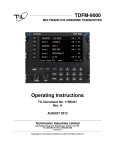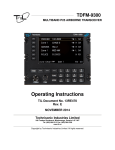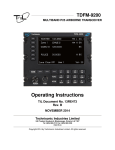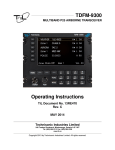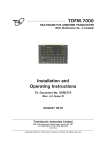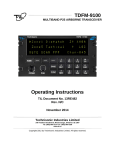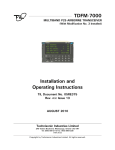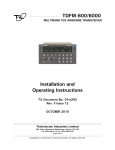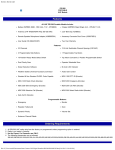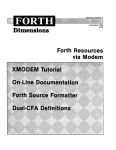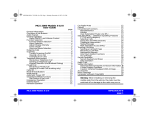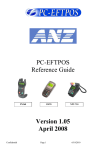Download TDFM-9000 Operating Instructions
Transcript
TDFM-9000 MULTIBAND P25 AIRBORNE TRANSCEIVER Operating Instructions TiL Document No. 11RE441 Rev. C MAY 2014 Technisonic Industries Limited 240 Traders Boulevard, Mississauga, Ontario L4Z 1W7 Tel: (905) 890-2113 Fax: (905) 890-5338 www.til.ca Copyright by Technisonic Industries Limited. All rights reserved. TECHNISONIC INDUSTRIES LIMITED REVISION HISTORY [ 11RE441 ] REV SECTION - PAGE - A i B C DATE EDITED BY Replaced TDFM-9000 Photo with Current Picture. Aug. 13, 2013 SM 2-8 Document Now References Correct TIB. Oct. 29, 2013 AL 2-9 Programming and Keyloading Cables Corrected. iv 1-2 2-4 All Changed STC Approval Note. Added Special Order Band Codes. Corrected Mislabeled Section Reference Number. Changed Format for Section Headers. May 12, 2014 AL DESCRIPTION TDFM-9000 Operating Instructions TiL 11RE441 Rev. C ii TECHNISONIC INDUSTRIES LIMITED NOTES CAUTION STATIC SENSITIVE ! This unit contains static sensitive devices. Wear a grounded wrist strap and/or conductive gloves when handling printed circuit boards. FCC COMPLIANCE INFORMATION This device complies with Part 15 of the FCC Rules. Operation is subject to the following two conditions: (1) this device may not cause harmful interference and (2) this device must accept any interference received, including interference that may cause undesired operation. WARNING: For compliance with FCC RF Exposure Requirements the mobile transmitter antenna installation shall comply with the following two conditions: 1. The transmitter antenna gain shall not exceed 3 dBi. 2. The transmitter antennas shall be located outside of a vehicle and must not be co-located (kept at a separation distance of more than 20cm from each other when installed). Also they must be installed in such a way that they always maintain a separation distance of more than 90cm from any person during operation. NOTE: This equipment has been tested and found to comply with the limits for a Class A digital device, pursuant to Part 15 of the FCC Rules. These limits are designed to provide reasonable protection against harmful interference when the equipment is operated in a commercial environment. This equipment generates, uses, and can radiate radio frequency energy and, if not installed and used in accordance with the instruction manual, may cause harmful interference to radio communications. Operation of this equipment in a residential area is likely to cause harmful interference, in which case the user will be required to correct the interference at his/her own expense. WARNING Changes or modifications not expressly approved by Technisonic Industries could void the user’s authority to operate the equipment. WARRANTY INFORMATION The Model TDFM-9000 Transceiver is under warranty for one year from date of purchase. Failed units caused by defective parts or workmanship should be returned to: Technisonic Industries Limited 240 Traders Boulevard Mississauga, Ontario L4Z 1W7 Tel: (905) 890-2113 Fax: (905) 890-5338 TDFM-9000 Operating Instructions TiL 11RE441 Rev. C iii TECHNISONIC INDUSTRIES LIMITED SUMMARY OF DO-160G ENVIRONMENTAL TESTING Summary of DO-160G Environmental Testing for Technisonic Model TDFM-9000 Transceiver: Conditions Category Temperature and Altitude A2, B1, C4, D1 Temperature Variation B Humidity A Operational Shock and Crash Safety A Vibration S, U Magnetic Effect Z Power Input B Voltage Spike B Audio Frequency Susceptibility B Induced Signal Susceptibility AC Radio Frequency Susceptibility T Radio Frequency Emission M Electrostatic Discharge A STC APPROVAL NOTE Presently, no TSO standard exists for airborne FM transceivers. To make it easier for installation agencies to provide their customers with an approved installation supported by an effective Airworthiness Approval, Technisonic has secured Supplemental Type Certificate (STC) approval. The above referenced DO-160G test data is also on file and available from Technisonic to support approval requirements in airframes for which Technisonic does not possess an STC. Approved aircraft types are listed in the attachments to the formal STC documents. These STCs are the exclusive property of Technisonic and require the written authority of Technisonic for their use. To assist Factory Authorized Technisonic Dealers in the certification process, we have placed copies of our Canadian and US STCs on our website along with a letter of authorization for their use. These documents may be downloaded and used as support for the technical submission to FAA or Transport Canada. Only authorized factory dealers/installers are permitted to download and make use of these documents on behalf of their customers (end users) in support of regulatory agency approval. Please refer to the Technisonic website www.til.ca for the latest issue of available STCs and letter of authorization for use. WARNING AND DISCLAIMER This manual is designed to provide information about the TDFM-9000. Every effort has been made to make this manual as complete and accurate as possible. TRADEMARK NOTICES TDFM-9000 Transceivers contain two-way radio protocols licensed from Motorola, Inc. © 1997, 1998 Motorola, Inc. TDFM-9000 Operating Instructions TiL 11RE441 Rev. C iv TECHNISONIC INDUSTRIES LIMITED TABLE OF CONTENTS FIGURE TITLE PAGE INTRODUCTION ...................................................................................................................... DESCRIPTION ......................................................................................................................... MODEL VARIATION ................................................................................................................ TECHNICAL CHARACTERISTICS .......................................................................................... 1-1 1-1 1-1 1-3 SECTION 1 1.1 1.2 1.3 1.4 SECTION 2 2.1 2.2 2.3 2.4 2.5 2.6 2.7 2.8 2.9 2.10 2.11 2.12 2.13 2.14 2.15 2.16 2.17 2.18 2.19 2.20 GENERAL DESCRIPTION B OPERATING INSTRUCTIONS B GENERAL ................................................................................................................................. FRONT PANEL ........................................................................................................................ POWER SWITCH .................................................................................................................... KNOB ........................................................................................................................................ SOFT KEYS AND HOME ......................................................................................................... MODE KEY ............................................................................................................................... FUNC KEY ................................................................................................................................ F1 to F4 KEYS .......................................................................................................................... MUP(4) AND MDN(7) KEYS (Memory Up and Down Keys) .................................................... UP(5) AND DOWN(8) KEYS .................................................................................................... BRT(6) AND DIM(9) KEYS ....................................................................................................... ESW(0) KEY (Ergo Switch Key) ............................................................................................... TSW(*) KEY (Toggle Switch Key) ............................................................................................ DISPLAY ................................................................................................................................... GENERAL OPERATION .......................................................................................................... CUSTOMER PROGRAMMING SOFTWARE (APX CPS) ....................................................... CONFIGURATION MENU ........................................................................................................ KEYLOADING MODE ............................................................................................................... FRONT PANEL PROGRAMMING (FPP) MODE .................................................................... FLASH UPGRADE MODE ....................................................................................................... 2-1 2-1 2-2 2-2 2-2 2-3 2-3 2-4 2-6 2-6 2-6 2-7 2-7 2-7 2-7 2-8 2-10 2-11 2-11 2-13 LIST OF FIGURES FIGURE 2.1 2.2 2.3 TITLE PAGE Front Panel Controls – TDFM-9000 Transceiver ..................................................................... 2-1 Programming Cable: P/N 127499 ............................................................................................. 2-9 Encryption Keyloading Cable: P/N 127500 ............................................................................... 2-9 LIST OF TABLES TABLE 2.1 2.2 TITLE PAGE TDFM 9000 Series PL/MOT Codes .......................................................................................... 2-12 TDFM 9000 Series DPL Codes (All Bands) ............................................................................. 2-13 TDFM-9000 Operating Instructions TiL 11RE441 Rev. C v TECHNISONIC INDUSTRIES LIMITED SECTION 1: GENERAL DESCRIPTION 1.1 INTRODUCTION This publication provides operating information on the TDFM-9000 airborne transceiver. The exact configuration depends on which and how many RF modules are installed. 1.2 DESCRIPTION The TDFM-9000 transceiver is an airborne multi-band radio capable of operation in conventional, analog, P25 and P25 phase II digital FM systems, SmartNet/SmartZone trunking systems, and P25 9600 trunking systems. RF modules are available in single or dual bands that support VHF, UHF-LO, UHF-HI, and 700-800 MHz bands. Up to 6 single or dual band modules can be supported. P25 9600 trunking Phase 1 and 2 may be combined with AES and/or DES-OFB encryption with OTAR in any of the available modules. 1.3 MODEL VARIATION There are several variations of the Model TDFM-9000 Transceiver. Each variation offers different features and performance based on the type of RF modules and options installed. RF Modules are mounted in trays of two (with up to 3 trays supported). The following is a breakdown of the TDFM-9000 model variations: P/N 101263-D-90-TBB-TBB-TBB-P9XXXX (PRODUCT TYPE)-(D)-(9X)-(Tray 1)-(Tray2)-(Tray3)-(Project) PRODUCT TYPE: 101263 = TDFM-9000 series, 3 trays, 2 – 6 modules D= Display type: 1) Color TFT 2) Standard Green/NV 9X = TDFM-9000 series variant: 90 = TDFM-9000 TDFM-9000 Installation Instructions TiL 11RE441 Rev. C 1-1 TECHNISONIC INDUSTRIES LIMITED Tray Breakdown: (TBB): T= Module type: A= T30xx RF modules (Single or Dual) B is Band code for each module in the tray. Band Codes 1 2 3 4 A B C D E F *G *H *I *J *K *L VHF (136-174) UHF LO (380-470) UHF HI (450-520) 700/800 (764-870) V/700/800 V/UHF LO V/UHF HI UL/UH UL/700/800 UH/700/800 700/800/V 700/800/UL 700/800/UH UHF LO/V UHF HI/V UH/UL Band numbers indicate single band modules and letters indicate dual band modules. * Band codes are special order and are not standard configuration. Project Number: P9XXXX represents a 5 digit project number that identifies specific options that are contained in each module and describes the full TDFM-9000 configuration. All model variations are capable of supporting both 28 Volt and 5 Volt AC or DC back lighting. The units are shipped set to operate on 28 Volt back lighting. Equipment can be set to operate on 5V back lighting by using the software based configuration menu. See Section 2.17 Configuration Menu. Damage will not occur if the incorrect voltage is applied. TDFM-9000 Installation Instructions TiL 11RE441 Rev. C 1-2 TECHNISONIC INDUSTRIES LIMITED 1.4 TECHNICAL CHARACTERISTICS Specification Characteristic Model Designation: Physical Dimensions: Weight: Operating Temperature Range: Power Requirement: Voltage: Current: Audio Output Power (including sidetone): Microphone Inputs: Panel Back Lighting: Voltage: Current: TDFM-9000 Approx. (L) 8.0" x (W) 5.75" x (H) 4.5" ~7.0 Lbs (3.2 Kg) -30° C to +60° C 28.0 VDC ± 15% 500 mA minimum / 7.5A maximum 65 mW into 600 Ω Carbon or Equivalent 28 or 5 Volts AC or DC (selectable) 10 uA RF Modules Specification Characteristic RF Output Power: 1 or 6 Watts (VHF) 1 or 5 Watts (UHF) 1 or 3 Watts (700/800) Frequency Range VHF Band: UHF LO Band: UHF HI Band: 700 / 800 bands: 136 to 174 MHz 380 to 470 MHz 450 to 520 MHz 764 to 870 MHz No. of channels per band: 2000 pre-programmable channels Transmitter section FM Hum and noise in dB (wideband): Audio Distortion: Frequency Stability in ppm: Modulation Limiting: VHF UHF -48 -45 1% 1.0% ± 1.0 ± 1.0 Wide band Narrow band 800 -45 1.0% ± 1.5 ± 5 kHz ± 2.5 kHz Receiver section Sensitivity in uV: * Digital 1% BER (12.5 kHz) * Digital 5% BER (12.5 kHz) ** Analog with 12 dB SINAD VHF UHF 800 0.29 0.21 0.25 0.32 0.28 0.25 0.40 0.30 0.25 Selectivity in dB: 25 kHz Channel 12.5 kHz Channel Intermodulation * ** -80 -70 -80 -78 -68 -80 -72 -67 -80 * Measured in digital mode per TIA / EIA IS 102.CAAA under nominal conditions. ** Measured in analog mode per TIA / EIA 603 under nominal conditions. TDFM-9000 Installation Instructions TiL 11RE441 Rev. C 1-3 TECHNISONIC INDUSTRIES LIMITED SECTION 2: OPERATING INSTRUCTIONS 2.1 GENERAL A colour LCD display, a keypad, and a rotary knob provide the operator control of up to 6 RF modules installed in the unit. The display shows the activity of all 6 modules as well as the soft key menu of the active band. The active module is selected by pressing the corresponding soft key on the left of the display. The knob has multiple functions including volume and channel. The microphone, key line, and headphone audio can be wired separately for each of the 6 modules; therefore, switching from band to band is performed at an audio panel such as the Technisonic A71X series. This allows for separate and simultaneous operation on each of the bands (just like having 6 separate radios). The transceiver can also be connected so that all bands are available on one of the combined outputs. In this configuration, the soft keys on the transceiver provide the audio panel function. It is possible to connect the transceiver such that both methods are used. 2.2 FRONT PANEL Refer to the diagram below: Band / Soft Keys For Band Selection and Menu Functions Zone Name Channel Name Technisonic TDFM-9000 Zone 1 DISPATCH X H OA / Zone 4 FLIGHT OPS L OA Zone 1 MEDEVAC H OC Zone 2 DIVISION 52 L OB Zone 6 TACTICAL L OA / Zone 1 PHONE PATCH H OB MUTE SCAN VIEW User 1 Condition Indicators / Symbols: - Scanning - Direct (Talk Around) - Monitor X - Band Muted in combined mode H - Power Indicator O / - Ergo Switch Position A - Toggle Switch Position - Green = Squelch Open / Red = TX Channel - 295 Soft Menu Items The Soft Keys below assume these functions Line Highlighting: Yellow - Band is Selected - User 1 Blue - Band is Selected - User 2 Knob function and value Multifunction Knob can control Volume, Channels and main Power Switch Programming Port for downloading Channels, Encription keys and Flash Upgrades. User 1 or 2 indication Key Pad FIGURE 2-1 Front Panel Controls – TDFM-9000 Transceiver TDFM-9000 Installation Instructions TiL 11RE441 Rev. C 2-1 TECHNISONIC INDUSTRIES LIMITED 2.3 POWER SWITCH To switch the transceiver on, press and hold the knob until the radio powers up. The display will show TECHNISONIC and the software version installed followed by the model number along with which RF modules are installed. The display will then show the normal display. To switch off the transceiver at any time, press and hold the knob for 2 seconds until the display shows OFF and then release. If it is desired that the radio powers up with the radio master in the aircraft, an ‘always on’ mode can be set in the configuration menu. 2.4 KNOB The knob is a rotary encoder, which turns endlessly. The knob also has a push button incorporated in it so you can press the knob as well as turn it. The knob will start out as a volume control. Pressing the knob again will change its function to act as the channel selector. Another knob press will bring you to the recall mode. In the recall mode, typing in a Zone and Channel number will bring you quickly to that channel without scrolling through many channels. Pressing the knob again brings it back to the volume control mode. The current function of the knob is shown at the bottom right of the display. 2.5 SOFT KEYS AND HOME The transceiver has nine soft keys. The 3 soft keys below the display assume the function shown on the menu above them. The functions displayed depend on how the module was programmed with the customer programming software (APX CPS)™. These menu items can be different on a channel by channel basis. Typical menu items may include: ZONE - Pressing this function will prompt you for a new zone number which can be entered directly (if the keypad is in NUM LOCK mode) or scrolled using the UP(5) and DN(8) keys. MUTE - Selecting this function will prompt you for an on or off entry using the soft keys to mute the tones. Tones refer to the beeps heard when pressing buttons. PWR - Selecting PWR will allow the power output of the radio to be set to high or low. VIEW - The view function is used to view lists. Lists can include scan lists, phone numbers, call lists, and/or paging. FPP - Front Panel Programming mode allows you to program at the front panel without the customer programming software. This option is available on all standard modules. At any time while in one of these functions, you can escape back to the normal mode by pressing the HOME key. When programming the modules with the CPS™, it is suggested not to double up functions. For example, programming a soft key to CHAN would be redundant since there is already a channel function using the knob. The six soft keys to the left of the display are used to select the active band for which the knob and keyboard will control. If the radio is connected using the one or both of the combined inputs, the selected band will also be selected for transmit. If you press a key on a band that is already selected, the receive audio will be toggled off and on. This can be useful to temporarily mute distracting traffic. TDFM-9000 Installation Instructions TiL 11RE441 Rev. C 2-2 TECHNISONIC INDUSTRIES LIMITED 2.6 MODE KEY This button selects USER 1 or USER 2 mode when the unit is installed with both combined input/outputs connected. USER 1 or 2 will be indicated at the bottom of the display, and the selected band box will show yellow for USER 1 and blue for USER 2. 2.7 FUNC KEY Pressing the FUNC key will bring up the first functions menu: Quick Channels Pressing one of the side menu keys or F1-F4 keys will load a pre-programmed channel. Record Next Message Pressing this menu key will cause the transceiver to record the next message received on the selected band. Play Last Message Pressing this menu key will play the last message recorded. After selecting one of the above the radio will return to normal operating mode. Pressing the ESC soft key will return to normal operating mode without making any changes. Pressing the NEXT soft key will bring up the second function menu. TDFM-9000 Installation Instructions TiL 11RE441 Rev. C 2-3 TECHNISONIC INDUSTRIES LIMITED Cross Band Repeat You can select any two bands to cross band repeat. The repeat function is semi-duplex. This means the TDFM-9000 will retransmit from one band to another in both directions but not simultaneously. Configuration Enters the configuration menu (see Section 2.17 Configuration Menu). This is the same menu that can be invoked during boot up. Simulcast You can select 2 or more bands to transmit simultaneously. Simulcast is only available when using the one or both of the combined input/outputs. Simulcast can be used in conjunction with the cross band repeat mode. Quick Channel Programming Allows you to program a Hot Memory (zone/channel) to the F1 to F4 keys for each band. Simplex Repeat When turned on, the band selected will become a simplex repeater. Simplex repeat (sometimes called parrot repeat) will record an incoming message and immediately retransmit the message on the same frequency. Pressing the ESC soft key or the FUNC key will return the radio to normal operating mode without making any changes. 2.8 F1 to F4 KEYS Four function keys at the top of the keypad (when not programmed for quick channels as mentioned above) provide the same actions as the three side buttons and the top button found on the APX-7000 portable. They are as follows: F1 – Top-side-button (purple button) on the portable. F2 – Centre-side-button (with one dot) on the portable. F3 – Bottom-side button (with two dots) on the portable. F4 – Top button (orange button) on the portable. TDFM-9000 Installation Instructions TiL 11RE441 Rev. C 2-4 TECHNISONIC INDUSTRIES LIMITED TDFM-9000 Transceiver Recommended Keypad Menu Defaults: TDFM-9000 Transceiver ITEM Conventional Operation Portable SmartNet / SmartZone Operation ITEM F1 Key Upper Side Button 1 Monitor Unprogrammed F2 Key Middle Side Button 2 Nuisance Delete Unprogrammed F3 Key Bottom Side Button 3 Talkaround/ Direct Unprogrammed F4 Key Top Button Volume Set Tone Volume Set Tone MUP and MDN keys 16-Position Rotary Knob Channel Select Talkgroup Select ESW Key Two-Position Concentric or Ergo Switch Unprogrammed A (∅) Unprogrammed B (O) Unprogrammed A (∅) Unprogrammed B (O) TSW Key Three-Position Toggle Switch Blank PL Disable Scan (A) (B) (C) Blank PL Disable Scan (A) (B) (C) NOTE: It is possible to use Motorola’s Customer Programming Software (APX CPS™) to alter the default keypad settings of the TDFM-9000 radio. However, if custom key settings are chosen, it will not be possible for Technisonic to help the Pilot or other Radio User through operational difficulties. These questions will have to be referred to the Radio System Administrator responsible for customizing the settings. Technisonic recommends that the default key settings stay in place until all airframe installation and operational issues have been overcome. TDFM-9000 Installation Instructions TiL 11RE441 Rev. C 2-5 TECHNISONIC INDUSTRIES LIMITED Modules 1 through 6 of the TDFM-9000 Transceiver are programmable by Motorola CPS™. The following settings may be programmed for each Conventional Channel in a module: TX Frequency TX PL/DPL Code RX Frequency RX PL/DPL Code Time-Out Timer Scan List Phone Numbers Talkgroup IDs Encryption Key Assignment Zone Channel Name RX Signal Voice Type TX Signal Voice Type Network Access Code TX Power Private Call Type The following settings can be programmed for each mode in a P25 Trunked and/or SmartNet/SMART ZONE equipped radio: System Type System ID (NAC) Individual ID (UID) Coverage Type Affiliation Type Control Channel (s) Talkgroups Status Encryption Key Assignment TG Strapping Zone Scan List Scan Type Interconnect Phone Display Format Private Call Operation Site Alias The function keys, along with the rest of the keypad, revert to normal number keys during transmit and when NUM LOCK is selected by pressing the rotary knob. The F1 – F4 keys can be programmed as Hot Memory keys as mentioned in Section 2.7. Depending on the setting in the configuration menu, the keys can be permanently set to Hot Memories (channels) or used for other functions (normal). When the F1 – F4 keys are in the normal mode, they can still be used for Hot Memory Recall if the FUNC key is pressed first. 2.9 MUP(4) AND MDN(7) KEYS (Memory Up and Down Keys) These keys provide the same function as the rotary knob does when it is set to CHAN. These keys can be used to scroll through the channels. A single press will step the channel by one, but a push and hold will scroll to a desired channel number. The function of the rotary knob is automatically set to CHAN when either of these keys is pressed. 2.10 UP(5) AND DN(8) KEYS The keys provide the same function as the left, right, up, and down arrow keys on the portable. The UP key equates to the right arrow key and the DN is the left. These keys are used for a variety of functions, but in the normal operating mode they are used to scroll through the soft key menus. 2.11 BRT(6) AND DIM(9) KEYS Use these keys to dim or brighten the display. The radio powers up at full brightness for normal use but can be dimmed for night operations. TDFM-9000 Installation Instructions TiL 11RE441 Rev. C 2-6 TECHNISONIC INDUSTRIES LIMITED 2.12 ESW(0) KEY (Ergo Switch Key) The ESW key provides the function of the concentric or ‘ergo’ switch on the portable. The switch has two conditions which are represented by ‘O’ and ‘∅’. Pressing the ESW key toggles the condition back and forth. The condition is displayed at the right hand side of the display line (second character from the right). The ergo switch condition is saved when the unit is turned off. There are separate conditions for each band installed. The ESW key can be programmed with the CPS™ to a variety of functions such as low power, scan and secure, or encrypted mode. 2.13 TSW(*) KEY (Toggle Switch Key) The TSW key provides the function of the toggle switch on the portable. The switch has three conditions which are represented by ‘A’, ‘B’, and ‘C’. Pressing the TSW key toggles the condition A,B,C,A,B, etc. The condition is displayed at the far right hand side of the display line (last character on the right). The toggle switch condition is saved when the unit is turned off. There are separate conditions for each band installed. The TSW key can be programmed with the APX CPS™ to a variety of functions such as low power, scan, zone select, or pl disabled mode. 2.14 DISPLAY The transceiver has full colour LCD display. The zone name, channel name, condition symbols (scan, direct, call, secure, monitor, etc.), and switch settings will be displayed for each module. The active band as selected by the soft keys will be highlighted. The bottom line displays the menu items associated with the module selected and the mode of the knob. 2.15 GENERAL OPERATION Switch on the transceiver by pressing the knob. Select the desired band by pressing one of the band select keys on the left of the display. Select the TDFM-9000 on the aircraft audio panel. Press the knob again so that CHAN shows up on the bottom right of the display. Rotate the knob until the desired channel or talk group is selected. Press the knob until VOL is again shown on the display. You can adjust the volume by waiting until a signal is received or by pressing F1 (factory programmed for monitor function) and adjusting the rotary knob. The radio is ready to use. If the radio is installed in separate mode, remember that the band selected by the soft keys is what menu is displayed on the screen but the band selected by the audio panel is the band that you are transmitting and receiving on. To use the DTMF keypad while transmitting, the band you are using must be selected on the display. If the radio is installed using both of the combined input/outputs, then pressing the MODE key will alternate the display between the two users. TDFM-9000 Installation Instructions TiL 11RE441 Rev. C 2-7 TECHNISONIC INDUSTRIES LIMITED 2.16 APX CUSTOMER PROGRAMMING SOFTWARE (APX CPS™) Programming the Bands in the TDFM-9000 is usually done with the use of third party programming software. Customer programming software, or “APX CPS,” must be supplied by Motorola. However, conventional analog or P25 channels can be programmed at the front panel if each module is fitted with the Front Panel Programming option (FPP). See Section 2.19 for details. A Programming cable “PC-9000” is required to connect the computer to the TDFM-9000. Bands 1 - 6 in the TDFM-9000 are considered an APX-7000 portable by the APX CPS™ software. To program a band in the transceiver, it must be selected by pressing the appropriate band select key before running the APX CPS™. Follow the instructions supplied with the APX CPS™. The APX CPS Programming software (P/N RVN5224) must be purchased from Motorola On Line (MOL). For instructions on ordering Motorola parts and APX CPS software see Technical Information Bulletin TIBFM 17-01. This document is available on the Technisonic website at www.til.ca. On the main page, hover the cursor over “Project 25 Airborne FM.” A pull-down menu should appear. Click the TDFM-9000 link to go directly to the TDFM-9000 page and click the link for “APX CPS Programming Software/Cables Ordering Guide.” Refer to the section for Type “A” modules. The following cables for support of the TDFM-9000 can be purchased from Technisonic: P/N 127499 Download/Programming Cable (See Figure 2.2). P/N 127500 Encryption Keyload Cable (See Figure 2.3). Some TDFM-9000s may contain Type II (B) modules. This is a non-standard configuration. “Astro 25 Portable CPS” (P/N RVN4181) with the PC-9000 is the only way to load channel information into those bands. If encryption keys need to be loaded via a KVL-3000+, keyloader cable P/N 127500 may be also be obtained from Technisonic. This keyloader cable will plug into the front mini DIN connector of the TDFM-9000 transceiver. TDFM-9000 Installation Instructions TiL 11RE441 Rev. C 2-8 TECHNISONIC INDUSTRIES LIMITED FIGURE 2.2: Programming Cable: “PC-9000” P/N 127499 FIGURE 2.3: Encryption Keyloading Cable: “KVL-9000” P/N 127500 TDFM-9000 Installation Instructions TiL 11RE441 Rev. C 2-9 TECHNISONIC INDUSTRIES LIMITED 2.17 CONFIGURATION MENU Some features of the TDFM-9000 transceiver can be configured to the user’s preference. To enter the configuration menu, press the FUNC button, then NEXT and then select "Configuration" from the 2nd side button. The Configuration Menu can also be accessed by turning the unit on while simultaneously pressing the F4, ESW, and TSW keys. Hold the keys until the display reads ‘Configuration Menu.’ Select the Item by pressing the side button. Rotate the knob to select the desired condition. Press the "NEXT" soft key to access the next page of configuration items. Press "ESC" Soft key to exit Configuration at any time. The following menu items can be changed or modified: Knob Default – This will select which mode (volume or channel) the knob will be when the radio is first turned on. Vol/Chan Mode – When set to both, volume and channel functions are both available. If set to single, only the function set in the above knob default will be available. Recall Mode – When enabled, recall of a Zone and Channel is added to the available knob functions. Squelch Blink – When disabled, the squelch indicator lights will function normally. When enabled, the receive squelch lights will stay lit while a signal is present and then blink for a couple of seconds after the signal disappears. This can help to determine which band made the last call. Panel Lighting – Select 28 volts DC or 5 volts AC. No damage will occur if the wrong setting is made. F1-F4 Keys – If set to normal, the keys will emulate the side buttons on the portable. If set to channels, the keys become quick channel load keys. The channels can be programmed in the second function menu. Sidetone Level – Sets the sidetone level. The microphone and headphone audio become live while in this mode to facilitate setting to a comfortable level. Always On Mode – When enabled, the radio turns on and off with the aircraft radio master. Dual User Mode – Set to enabled when the radio is installed with both combined ports connected. Press the ESC button to exit configuration mode. The radio will return to normal operation display. The radio will keep these settings until they are changed again in the configuration menu. TDFM-9000 Installation Instructions TiL 11RE441 Rev. C 2-10 TECHNISONIC INDUSTRIES LIMITED 2.18 KEYLOADING MODE If the TDFM-9000 is equipped with hardware encryption, then the Encryption keys will need to be loaded using a Motorola KVL 3000+® or KVL 4000 Keyloader and a KVL-9000 cable, (TiL P/N 127500). Modules in the TDFM-9000 can easily be keyloaded by simply selecting the band and plugging in the keyloader and cable into the programming connector on the front of the radio. Turn on the keyloader and connect the cable to the TDFM-9000. The selected band will display "KEYLOADING". Follow the Motorola Keyloader instructions for uploading the actual keys to the radio. If other bands require keys, press the next soft key to select the next module, wait 1 second for the module to sense the keyloader, and then upload the key(s). When keyloading is done, remove the keyloader cable and Power cycle the TDFM-9000 to resume normal operation. 2.19 FRONT PANEL PROGRAMMING (FPP) MODE All type “A” and some type II modules have the capability to program channel information such as frequencies, PL tones, modulation types, etc. from the front panel. ‘FPP’ will show up as one of the soft menu items at the bottom of the screen if this option has been ordered. When the FPP soft key is pressed, the following screen will appear: The display shows all of the information contained in the current channel. Pressing one of the side menu keys will select the attribute to be edited. Toggling between transmit and receive can be done by either pressing the menu key again or by pressing the knob with the exception of the Name line which toggles between Zone Name and Channel Name. TDFM-9000 Installation Instructions TiL 11RE441 Rev. C 2-11 TECHNISONIC INDUSTRIES LIMITED Receive/Transmit Frequency – The frequency can be changed by entering a new value via the keyboard. Receive/Transmit CTCSS Tone – Rotate the knob to scroll through the available CTCSS tones. ACTCSS tone cannot be programmed if a DCS code is already active. Receive/Transmit DCS Code – Rotate the knob to scroll through the available DCS codes. A DCS code cannot be programmed if a CTCSS code is already active. Receive/Transmit NAC Code – Enter the desired NAC via the keyboard. The Network Access Code is a hex number between 000 and FFF. The standard number is 293. A soft menu key will allow toggling between 0-9 and A-F. Programming a NAC code on an analog channel has no effect. Receive/Transmit Type – Rotate the knob to scroll through Analog, P25, and Mixed (will receive both). Transmit can only be programmed to Analog or P25. Zone/Channel Name – Rotate the knob to scroll through the available characters. Press the NEXT soft key to get to the next position. Pressing next at the end of the name will loop back to the first character position. Press the HOME key or the DONE soft key to save your changes and return to normal operating mode. Press the ESC soft key to abandon any changes and return to normal operating mode. FPP can only be used on a memory containing a conventional analog or P25 channel. P25 or Motorola Trunking channels can only be programmed via APX CPS software. The following is a list of TDFM-9000 CTCSS/PL/MOT Codes: PL (Hz) 67.0 69.3 71.9 74.4 77.0 79.7 82.5 85.4 88.5 91.5 94.8 MCODE XZ WZ XA WA XB WB YZ YA YB ZZ ZA PL (Hz) 97.4 100.0 103.5 107.2 110.9 114.8 118.8 123.0 127.3 131.8 136.5 MCODE ZB 1Z 1A 1B 2Z 2A 2B 3Z 3A 3B 4Z PL (Hz) 141.3 146.2 151.4 156.7 162.2 167.9 173.8 179.9 186.2 192.8 203.5 MCODE 4A 4B 5Z 5A 5B 6Z 6A 6B 7Z 7A M1 PL (Hz) 206.5 210.7 218.1 225.7 229.1 233.6 241.8 250.3 254.1 CSQ MCODE 8Z M2 M3 M4 9Z M5 M6 M7 OZ CSQ TABLE 2.1 TDFM-9000 Series PL/MOT Codes TDFM-9000 Installation Instructions TiL 11RE441 Rev. C 2-12 TECHNISONIC INDUSTRIES LIMITED The following is a list of TDFM-9000 DCS/DPL CODES: 023 025 026 031 032 043 047 051 054 065 071 072 073 074 114 115 116 125 131 132 134 143 152 155 156 162 165 172 174 205 223 226 243 244 245 251 261 263 265 271 306 311 315 331 343 346 351 364 365 371 411 412 413 423 431 432 445 464 465 466 503 506 516 532 546 565 606 612 624 627 631 632 654 662 664 703 712 723 731 732 734 743 754 TABLE 2.2 TDFM-9000 Series DPL Codes (All Bands) 2.20 FLASH UPGRADE MODE On occasion, it may be required to flash upgrade one or more of the RF modules in the radio to change or add new features. This can be done using APX CPS software and a Motorola flash upgrade kit and the PC-9000 programming cable. Follow the instruction supplied with the flash upgrade kit for configuring and using the APX CPS. When the flash upgrade is completed, power cycle the TDFM-9000 to resume normal operation. For detailed instructions, refer to TiL document 136588 “FLASH UPGRADE PROCEDURE FOR TDFM-9000 SERIES RADIOS.” Notes: TDFM-9000 Installation Instructions TiL 11RE441 Rev. C 2-13





















